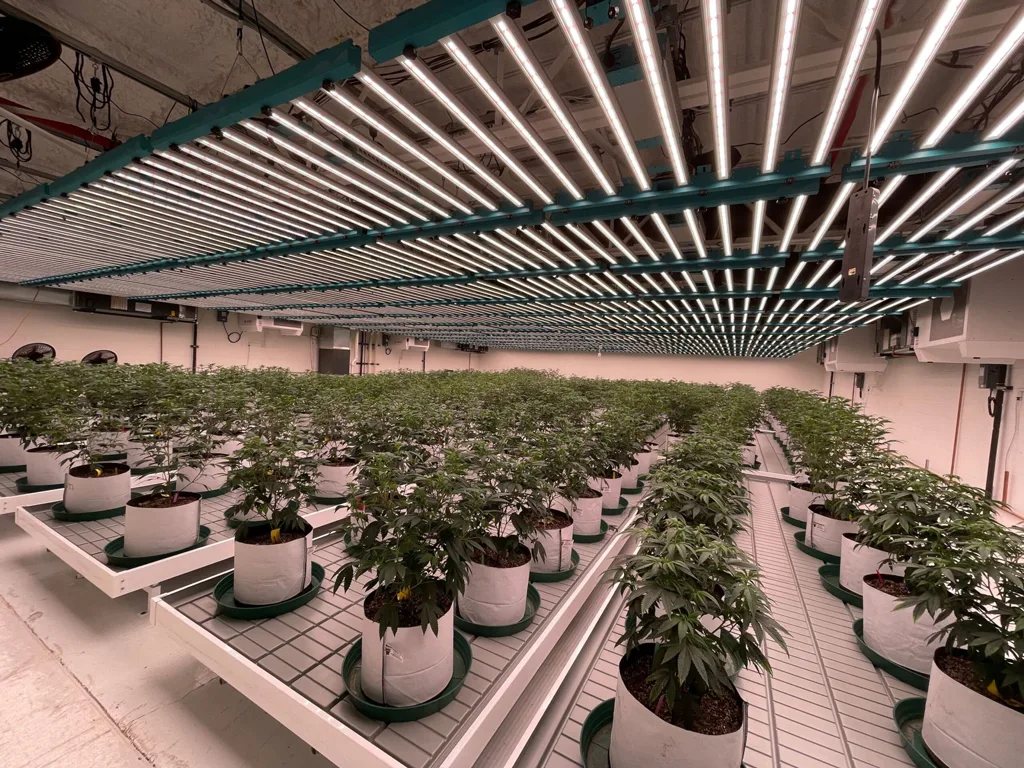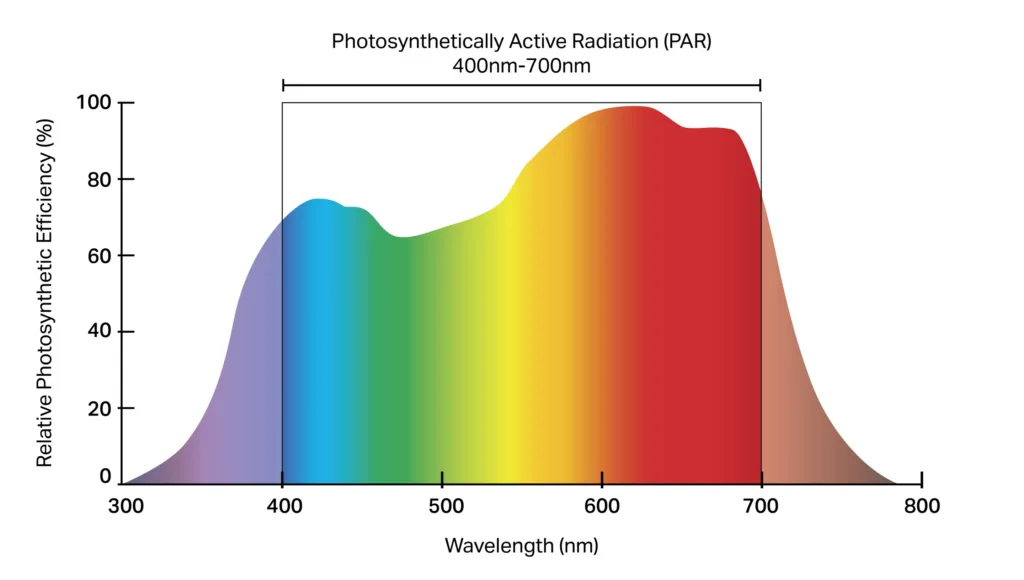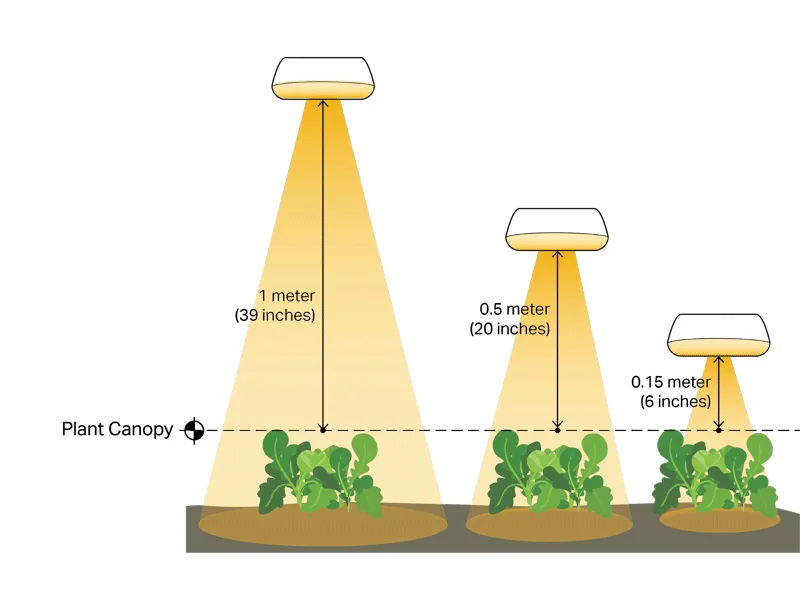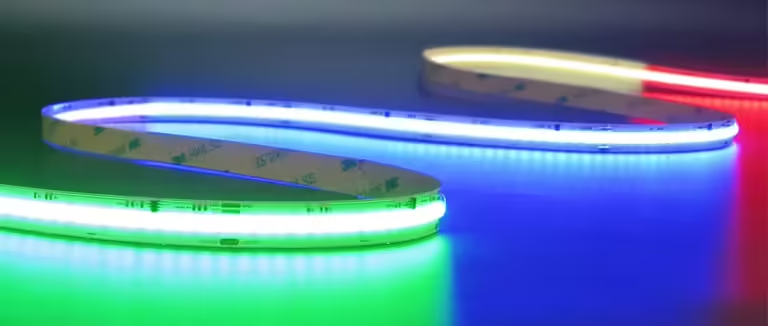Changes in marijuana laws in some states have put LED grow light products for home marijuana gardening in the spotlight. Some states have passed bills that allow them to openly grow marijuana—and we are happy to share our horticultural lighting expertise with you!
Today, more and more growers are moving away from traditional HID and fluorescent grow lights and are installing LED lighting. LEDs emit less heat than HID light sources, which means that LED grow lights are at a different distance from the canopy than traditional grow lights. It’s also important to understand how the optimal grow light distance affects the different stages of plant growth.
Whether you’re looking to invest in commercial grow lights to supply a large-scale crop for a dispensary or just want to grow a few plants yourself, our LED horticultural grow lights can increase your yields while controlling ambient heat and utility costs. Let’s take a deeper look at how horticultural LED grow lights can help you produce the fattest, tastiest buds!

Why are LED Grow Lights for Cannabis in Horticulture?
LED grow lights are energy-efficient lamps that are also used by indoor and greenhouse farmers as well as cannabis growers.LEDs can be used as a sole source of light (indoors) or as a secondary source of light (greenhouses) to help grow plants using full-spectrum illumination for less than the cost of traditional HPS lights.
Many growers utilize LED lights to help expand plant production due to their full spectrum capabilities, low heat waste and maintenance, and longer lifespan. Since plant physiology and morphology are strongly influenced by a specific spectrum of light, LED grow lights can effectively promote crop growth at specific times in the growing cycle. By closely monitoring quality, energy output can be easily assessed to expand crop production.
The spectral map of growth light used by plants for photosynthesis includes both the PAR range as well as other spectra, as wavelengths outside the PAR range have been found to contribute to plant growth.

The peaks in photosynthetic efficiency (light absorption) are located in the red and blue light spectra in the PAR range. Red light (~700 nm) is thought to be the most efficient in driving photosynthesis, especially during the flowering phase of biomass growth (important for marijuana growers). Blue light is essential for both the nutrient and flowering stages of plant growth but is primarily used to establish nutrient and structural growth.
How Much Light Does Cannabis Need to Grow Indoors?
Cannabis plants grow best in true daylight. They need a full spectrum of light for full growth, but adding certain wavelengths of light helps them achieve higher densities and higher bud yields.
Adding far-red gardening lights to a full-spectrum setup takes advantage of a plant’s natural shade avoidance response. When a plant senses the presence of far-red photons, it perceives them as shade. This triggers the plant to seek out more light, which leads to faster growth with longer stems and wider leaves. Far-red wavelengths also increase the efficiency of photosynthesis, which means you get higher crop yields and shorter production times.
Using the right light cycle when growing marijuana can significantly impact the overall health of your plant. Because cannabis requires specific light conditions throughout its life stages, everything from the amount of light to the timing and duration of light can potentially affect yield. Light intensity is typically measured in units of photon flux density (PPFD), which measures the amount of photons arriving per second (in µmol/m2/s) over a given area. The need for light intensity varies at different growth stages.
Germination and Seedling Stage
At the germination and seedling stage, plants are more fragile and do not require much light. Typically, a PPFD of 100-300 µmol/m2/s is sufficient to meet their basic needs in order to avoid excessive light damage to the seedlings. Softer light is recommended at this stage.
Vegetative Stage
As the plant enters the vegetative stage, its need for light increases in order to accelerate leaf and root growth. The optimal light intensity for this stage is 400-700 µmol/m2/s, and cannabis typically requires 18-24 hours of light to support rapid growth.
Flowering
Cannabis in the flowering phase has a higher light intensity requirement, and it is recommended to maintain a light intensity of 800-1500 µmol/m2/s to promote bud differentiation and cannabinoid accumulation. During this phase, cannabis enters a cycle of 12 hours of light and 12 hours of darkness, which initiates its flowering mechanism. Photoperiod management during flowering is critical, as slight errors may affect flowering effects and yields.
How Far do Grow Lights Need to be From Indoor Plants?
As plants grow, their needs change. Once the nutrient growth stage is complete, plants enter the flowering, or “blooming” stage. For mature plants, they are already in the position they need to grow. During the flowering stage, LED grow lights should be located 16-36 inches from the plant canopy. Moving the grow light closer will increase light intensity to maximize photosynthesis. However, if the grow lights are too close to the plant, they may cause the plant to grow wider, more sprawling, or even damage the plant. What about other growth stages?
Plants require different levels of light at different stages of growth. To accurately know the distance between your plant grow lights and your plants, you must consider the different growth stages. It’s also important to consider the power output of the grow light; this is usually related to the wattage of the light source, which is a major factor in determining the optimal distance for the LEDs at the start of the growing process.
Plant growth can be broadly categorized into three different stages: seedling, nutrient growth, and flowering.
Seedling Stage
During the initial seedling stage, LED grow lights should be placed higher up from the plant to avoid drying out the soil.
Some growers may try to stimulate seedlings with high-intensity light to promote rapid growth, but this won’t help until the plants are mature. Seedlings are too fragile at this early stage and need a gentler approach. Once the plants have matured, higher light intensities are needed to promote photosynthesis.
So place your grow lights 24 to 36 inches away from your seedlings.
Vegetative Stage
During the vegetative stage, plants respond well to bright light; it is during this time that they are maturing and using photosynthesis to grow rapidly. To increase light intensity, LED grow lights should be placed close to the plant canopy. Strong, healthy stems and roots are key to successful and repeatable yields.
While increasing light intensity can promote growth during the vegetative growth phase, it is important to monitor the plants closely and be sure to watch for undesirable symptoms caused by too much or not enough light.
During this period, only 12 to 24 inches of distance is needed between the canopy and the horticultural LED grow lights.
Flowering
Flowering is the final stage of the plant growth cycle, during which fruit production and stem growth accelerate. As plant growth transitions from the nutrient stage to the flowering stage, it’s best to “phase” this transition. To do this, gradually move the height of the LED grow lights away from the plant canopy. Closely monitor the distance, keeping in mind the crop height and flowering needs required for a particular plant or crop.
Gradually raise the height of the lights 16 to 36 inches above the canopy as the marijuana enters the bud or flowering stage. If you’re cloning branches from mature cannabis plants, treat the clones as you would nutritious plants, gradually moving the LED grow light source closer—12 to 24 inches above the canopy—to help establish a strong root base.
Adverse Effects of Too Much Light
Plants like marijuana often show signs of discomfort when they receive too much light at any given stage. Since LEDs don’t give off much heat, the main issue to monitor closely is any signs of “light burn.” Other side effects associated with grow lights placed too close to the plant canopy can be discoloration or stunted/irregular growth. It is important to quickly recognize both of these conditions and adjust the grow light height accordingly.
Signs of light burn in marijuana plants include upturned leaves and what is known as “whitening.” Whitening is when leaves near the light turn white or yellow. Light burn can also be recognized when the plant’s leaf veins turn green and the rest of the leaves turn yellow.
LED Grow Light Distance Chart

| Distance from Plant Canopy | Intensity | PPFD / PAR | Coverage |
| (meters/inches) | (Lux) | (μmol/m-2/s-1) | (m² / ft2) |
| 2m / 79 inches | 955lx | 670 | 7.6m2 / 81.8ft2 |
| 1.5m / 59 inches | 1692lx | 1170 | 5.0m2 / 53.8ft2 |
| 1m / 39 inches | 3663lx | 1670 | 3.0m2 / 32.3ft2 |
| 0.5m / 20 inches | 12,500lx | 2170 | 1.5m2 / 16.1ft2 |
| 0.2m / 8 inches | 50,300lx | 2670 | 0.5m2 / 5.4ft2 |
The chart shows the performance of the 600W LED grow light at different distances from the plant canopy. It summarizes light intensity (lux), PPFD (μmol/m2/s-1, or micromoles per square meter per second), and also shows the “light footprint,” or canopy coverage. Intensity, PPFD/PAR, and “light footprint” all vary as the distance of light from the plant canopy increases or decreases.
The chart also highlights how varying the distance from the same 600-watt LED light changes the intensity of light received by the plant and the “light footprint,” or canopy cover. The closer the light source is to the canopy, the higher the light intensity. In general, grow lights should be mounted close to the plant canopy during the growth phase of the plant and higher (further away) from the plant canopy during the flowering phase of growth.
How Many Hours Per Day Should I Use My Grow Light?

To germinate, marijuana seeds only need moisture, heat, and time alone. Once the primary roots appear, make sure the overhead light is about 24 inches above the soil surface and keep the light on for 10 to 12 hours a day. For the best start for seedlings, LED grow lights that include a far-red spectrum provide gentle, attentive gardening care.
During the vegetative growth phase, when leaves and stems are growing rapidly, plants need long periods of sunlight and very short periods of darkness. A minimum of 13 hours of full-spectrum light is a must, but many home growers prefer an 18/6 light schedule of 18 hours during the day and 6 hours at night.
For obvious reasons, the germination phase is often the most important phase for cannabis growers. Marijuana plants begin to germinate when they are without light for at least 12 hours a day. Stick to the 12/12 schedule—12 hours of full LED grow light illumination followed by 12 hours of complete darkness—until buds are ready to be harvested. This can take up to 6 weeks to 5 months, depending on the variety you’re growing.
Implementing the optimal light cycle for your flowering cannabis plants is crucial to ensuring maximum yield, and most cannabis growers know that darkness is just as important as light. Whether your greenhouse is located in the Pacific Northwest during the long summer months or in the Central Valley in a hotter climate, balancing darkness and light is essential for maximum bud production.
The light cycle during the day provides the plants with the energy they need, and the night provides the darkness that keeps cannabis on some sort of natural biological clock. This is why indoor growers need to make a deliberate effort to not only create long, bright days but also to mimic the dark cycle that allows cannabis to grow large, full buds.
Here are two tips that may help you make your next project easier:
- Stick to the schedule you’ve chosen: If you decide to go with the classic 12/12 light schedule of covering your plants at 7 p.m. and uncovering at 7 a.m., stick to that schedule. Keep in mind that this schedule requires adequate ventilation, so some growers choose to uncover their plants at night when the sky is completely dark.
- Uninterrupted darkness: Many growers don’t realize that the optimal light cycle for flowering requires an uninterrupted cycle of darkness. Just as a light coming on suddenly at 2am will interrupt your good REM sleep, cannabis will not get better if it is disturbed by any light during its dark “sleep” cycle. The moon and stars won’t disturb the cannabis, but any artificial light will stop the buds from growing. In fact, light interrupting its dark cycle will make the cannabis so nervous and irritable that it will cause hermaphroditism. This will cause the females to pollinate and ruin your plants.
Why Choose SignliteLED’s Horticultural LED Grow Lights?
The ideal horticultural lighting setup depends on several factors, including:
- The size of your space
- Light intensity needed for the particular marijuana variety
- The stage of growth the plant is going through
- Your budget and energy usage
With all of these factors in mind, a basic setup should include at least one light source: an overhead light. Generally, start with a top light (also known as a top LED grow light), which provides a full spectrum of light to the plants. Its intensity is the same as the sun’s, which provides the plants with nutrients and promotes rapid growth, eventually producing a large number of buds.
There seems to be a lot of discussion about the gardening products needed for top-of-the-line home grow equipment. But choosing the right LED grow light for your situation really boils down to the two factors we mentioned earlier: the size of your space and your concerns about budget and energy use.
SignliteLED’s LED gardening lighting has your back. Want to know 5 good reasons to choose SignliteLED gardening products to light your best crops? Check it out here:
Efficient Full Spectrum Coverage: LED horticulture lights outperform most other options in providing powerful full spectrum light at optimal efficiency for plant growth.
Far-Red Wavelengths: Recent studies have shown that enhancement of far-red wavelengths enhances photosynthesis and overall plant quality, and LEDs are one of the few light sources capable of providing far-red wavelengths.
Quick and Easy Installation: SignliteLED Horticultural Lighting can be quickly hung and plugged in, or easily connected to a household power source. In addition, the Foldable and Removable ranges feature a quick-connect daisy-chain system for rapid expansion.
Low Maintenance and Replacement Costs: All SignliteLED Horticultural LED Grow Lights are designed to provide superior light with up to 50,000 hours of worry-free maintenance.
Low Heat Output and Energy Consumption: LEDs are much cooler than incandescent and metal halide bulbs, eliminating the need for a cooling system, and LEDs won’t add to your electric bill because they use up to 75% less energy than other grow light options.
Horticultural Lighting with SignliteLED
The introduction of LED plant grow lights has opened up new possibilities for cannabis gardening. Growers can optimize plant growth at all stages by understanding the light needs of different growth stages and rationally regulating light intensity, duration, and distance from the fixtures. SignliteLED’s premium LED horticultural grow lights provide growers with an efficient, flexible lighting solution that makes high-quality cannabis output easier and more efficient.




